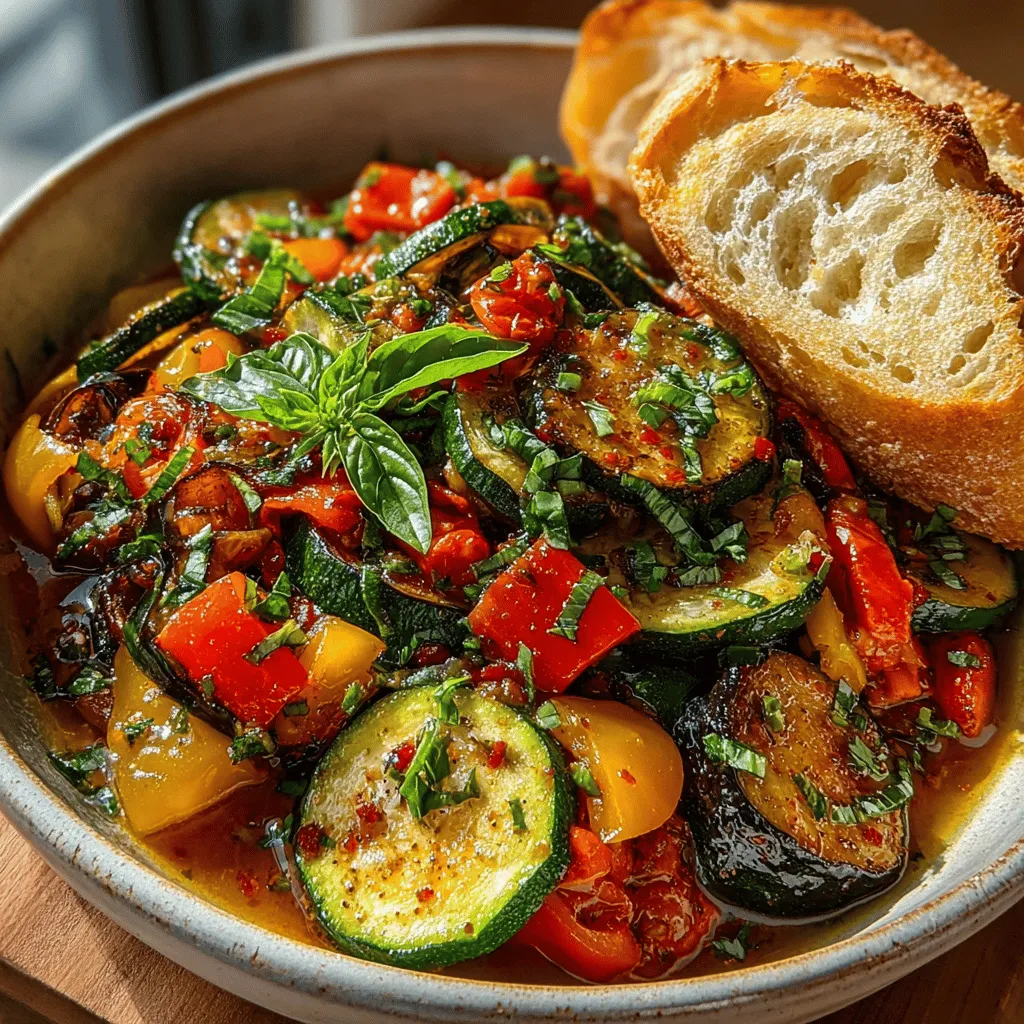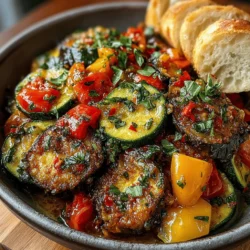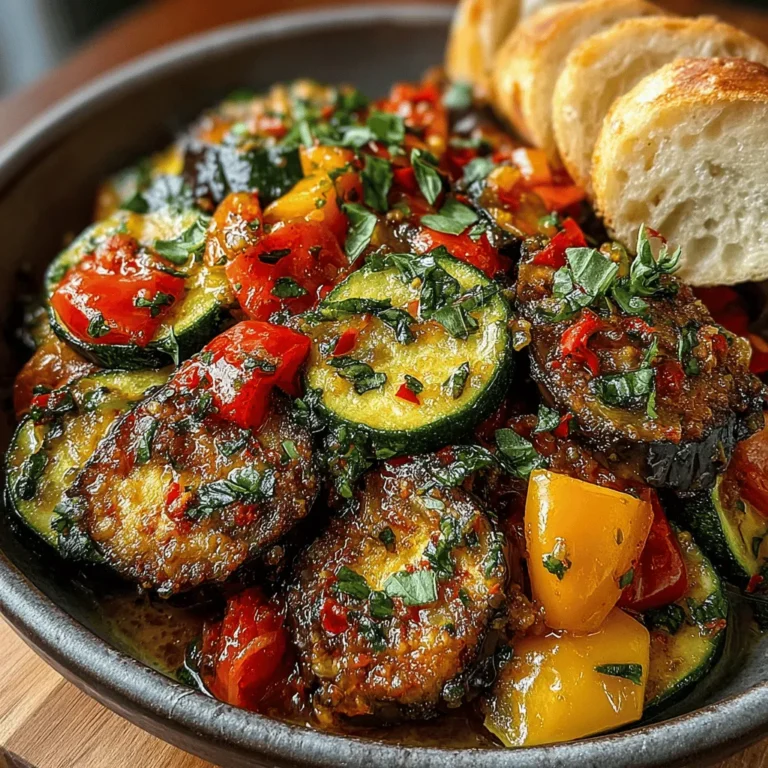Introduction to Ratatouille Bliss with Crusty Bread
Ratatouille, a classic Provençal dish, is more than just a colorful assortment of vegetables; it represents the essence of summer and the richness of French culinary tradition. This Ratatouille Bliss paired with crusty bread is not only a delightful vegetarian option but also a celebration of seasonal produce that delivers both flavor and nutrition. As you delve into this recipe, you will discover how accessible and rewarding it is, whether you are an experienced chef or just starting your culinary journey.
The beauty of ratatouille lies in its versatility. It can be served warm or cold, as a main dish or a side, and pairs beautifully with crusty bread that perfectly complements its rich flavors. The crispy texture of the bread enhances the experience, allowing you to scoop up the vibrant vegetable medley with ease. This dish is a feast for the eyes and a joy to the palate, making it an ideal choice for gatherings, family dinners, or a simple weeknight meal.
In this article, we will explore the origins of ratatouille, its key ingredients, and a step-by-step guide to crafting this delightful dish. By understanding the history and components of ratatouille, you’ll appreciate the depth of flavor it brings to your table and feel inspired to create your own Ratatouille Bliss.
Understanding Ratatouille: A Traditional French Dish
Exploring the History of Ratatouille
Ratatouille has its roots in the rustic kitchens of Provence, where fresh, seasonal ingredients are celebrated. Traditionally, this dish was a way for farmers to utilize the abundance of summer vegetables, particularly those that thrived in the Mediterranean climate. The name “ratatouille” is derived from the French word “touiller,” which means to stir up, reflecting the method of preparation that involves mixing various vegetables together.
The significance of seasonal vegetables in ratatouille cannot be overstated. Each ingredient contributes its unique flavor and texture, creating a harmonious blend that showcases the bounty of the harvest. Ratatouille not only nourishes the body but also embodies a philosophy of cooking that values simplicity and quality.
Culturally, ratatouille holds an important place in French cuisine. It is often associated with home-cooked meals and family gatherings, making it a beloved dish across generations. The dish gained international fame with the release of the animated film “Ratatouille,” which highlighted the artistry and passion behind cooking, further solidifying its status as a symbol of French culinary heritage.
Key Ingredients that Make Ratatouille Special
To create an authentic ratatouille, certain key ingredients are essential. The traditional vegetables used include eggplant, zucchini, bell peppers, tomatoes, and onions. Each of these vegetables brings its own character to the dish, contributing to the overall flavor profile.
Herbs and seasonings play a crucial role in elevating the dish. Fresh basil, thyme, and rosemary are commonly used, providing aromatic notes that enhance the natural sweetness of the vegetables. A drizzle of high-quality olive oil not only adds richness but also helps to meld the flavors together, making it a vital component of the dish.
In addition to these ingredients, the quality of your produce is paramount. Fresh, organic vegetables will yield the best results, as they are packed with flavor and nutrients. Choosing in-season produce ensures that your ratatouille is vibrant and delicious, capturing the essence of summer in every bite.
Step-by-Step Guide to Making Ratatouille Bliss
Creating the perfect ratatouille requires attention to detail, particularly when it comes to preparing the vegetables for maximum flavor. Here’s how to get started:
Preparing the Vegetables for Maximum Flavor
The first step is selecting the right vegetables for your ratatouille. Look for firm, glossy eggplants, shiny zucchinis, and brightly colored bell peppers. Fresh tomatoes should be ripe but not overly soft. When shopping, consider visiting a local farmers’ market to find the freshest produce available.
Once you have gathered your ingredients, the next step is to prepare them for cooking. Uniform chopping is key to ensuring that all vegetables cook evenly. Aim for bite-sized pieces, roughly the same size, which will help them blend seamlessly in the final dish.
Washing and handling the produce is equally important. Start by rinsing the vegetables under cool water to remove any dirt or pesticides. For eggplant, consider salting the slices to draw out excess moisture and bitterness. Simply sprinkle salt over the cut pieces and let them sit for about 30 minutes before rinsing and patting them dry. This step not only improves the flavor but also enhances the texture.
Sautéing Aromatics: The Foundation of Flavor
With your vegetables prepped, it’s time to build the foundation of flavor through sautéing aromatics. Onions and garlic are essential in this process, providing a savory base for your ratatouille. Start by heating a generous amount of olive oil in a large skillet or Dutch oven over medium heat.
Add finely chopped onions and sauté until they become translucent and fragrant, which usually takes about 5-7 minutes. Next, introduce minced garlic to the pan, stirring frequently to prevent it from burning. The combination of onions and garlic creates a rich aromatic backdrop that will enhance the overall taste of the dish.
Balancing oil and heat is crucial during this step. Use just enough oil to coat the bottom of the pan without making the dish greasy. Maintain a moderate heat to allow the onions to caramelize slowly, releasing their natural sugars and deepening the flavor profile of your ratatouille.
Incorporating Eggplant: The Heart of Ratatouille
Eggplant is often considered the heart of ratatouille, contributing a unique texture and flavor that defines the dish. When selecting eggplant, look for a firm, heavy specimen with a smooth, unblemished skin. Smaller varieties tend to be sweeter and less bitter, making them an excellent choice for this recipe.
Once your eggplant is prepped, it’s time to incorporate it into the sautéed aromatics. Add the eggplant to the skillet and cook until it begins to soften, stirring occasionally. This process typically takes about 5-10 minutes. You may notice that the eggplant absorbs a significant amount of oil; feel free to add a splash more olive oil if necessary to prevent sticking.
Addressing common concerns, such as bitterness and moisture, is important during this step. By salting the eggplant before cooking, you can reduce its bitterness and achieve a more pleasing texture. Additionally, cooking it thoroughly will help eliminate excess moisture, resulting in a beautifully balanced dish.
Building the Vegetable Medley: Layering Flavors
With the eggplant softened, it’s time to add the remaining vegetables to the skillet. Begin with the zucchini and bell peppers, which will cook relatively quickly. Stir them into the mixture, allowing them to cook for about 5 minutes until they start to soften.
Next, add the diced tomatoes, which will provide moisture and acidity to the dish. Stir well to combine all the ingredients and allow them to simmer together. The timing of adding each vegetable is crucial; you want to ensure that everything cooks evenly without becoming mushy.
As the ratatouille simmers, the vibrant colors of the vegetables will begin to meld, creating a beautiful medley. To maintain the brightness of the dish, avoid overcooking the vegetables. The goal is to achieve a tender yet slightly firm texture, allowing each ingredient’s individual flavors to shine through.
By following these initial steps, you will be well on your way to creating a delicious Ratatouille Bliss that is perfect for any occasion. In the following sections, we will delve deeper into serving suggestions, additional cooking techniques, and the health benefits of this exquisite dish.

Simmering to Perfection: Creating Depth of Flavor
Ratatouille is a traditional French dish that celebrates the vibrant flavors of summer vegetables, particularly tomatoes, which play a pivotal role. The key to a successful ratatouille lies in the depth of flavor achieved through careful simmering.
The Role of Tomatoes in the Dish
Tomatoes are essential for providing a rich, tangy base that binds the other ingredients together. When selecting tomatoes, opt for ripe, flavorful varieties such as Roma or heirloom tomatoes. These types have a robust taste that can stand up to the other vegetables. During cooking, the tomatoes will break down and form a sauce that enhances the overall dish. Allow them to simmer gently, releasing their juices and melding with the other ingredients.
Techniques for Achieving the Right Consistency
To achieve the perfect consistency for your ratatouille, begin by dicing your vegetables uniformly. This ensures even cooking. When you add the tomatoes, consider the following techniques:
– Sautéing Initially: Start by sautéing the onions and garlic in olive oil until soft. This creates a flavorful base. Then, add the chopped tomatoes and allow them to cook down for about 10 minutes.
– Simmering: After the initial sauté, add the other vegetables (zucchini, eggplant, bell peppers) and stir to combine. Cover the pot and let it simmer on low heat for 30-40 minutes. Stir occasionally to prevent sticking, and cook until the vegetables are tender yet retain their shape.
Adding Herbs for Aromatic Enhancement
Herbs elevate the flavor profile of ratatouille, giving it a fragrant aroma. Classic choices include:
– Thyme: Fresh or dried, thyme offers an earthy note that complements the vegetables beautifully.
– Basil: Adding fresh basil toward the end of cooking enhances the dish’s freshness.
– Oregano: This herb introduces a slightly pungent flavor that rounds out the dish.
To incorporate herbs, add dried herbs early in the cooking process to allow their flavors to infuse. Fresh herbs should be added at the end to maintain their vibrant taste and color.
Finishing Touches: Adding Balsamic Vinegar
Balsamic vinegar is a fantastic finishing touch for ratatouille, providing a sweet-tart flavor that balances the dish’s savory elements.
Why Balsamic Vinegar Can Elevate the Dish
The addition of balsamic vinegar brightens the ratatouille, enhancing its complexity. The acidity from the vinegar cuts through the richness of the vegetables, making each bite more dynamic.
Timing and Method of Incorporation
For the best results, add balsamic vinegar just before serving. Drizzle in about one tablespoon per serving, stirring gently to combine. This method prevents the vinegar from cooking off and losing its distinctive flavor.
Alternative Flavor Enhancers for Personal Preference
If balsamic vinegar isn’t to your taste, consider these alternatives:
– Red Wine Vinegar: Offers a similar acidity with a slightly different flavor profile.
– Lemon Juice: Adds a fresh citrus note that can brighten the dish.
– Soy Sauce: For a more umami flavor, a splash of soy sauce can be a unique twist.
Preparing Crusty Bread: The Perfect Accompaniment
No ratatouille is complete without a side of crusty bread. The bread serves not just as a side, but as a vehicle for savoring the rich flavors of the ratatouille.
Choosing the Right Bread for Ratatouille
When selecting bread, consider options that will complement the dish without overshadowing it.
– Baguette: A traditional French baguette, with its crispy crust and soft interior, is an excellent choice. The texture contrasts nicely with the tender vegetables of the ratatouille.
– Rustic Loaf: A hearty country loaf or sourdough can also pair well, offering a denser texture and robust flavor.
When purchasing bread, visit a local bakery and look for loaves that are fresh. The crust should be golden and hard, while the inside should feel light and airy.
Toasting Techniques for Added Crunch
To enhance the experience, toasting the bread is essential. There are two popular methods to achieve the ideal crunch:
– Oven Toasting: Preheat your oven to 400°F (200°C). Slice the bread and arrange it on a baking sheet. Drizzle with olive oil and toast for about 8-10 minutes, or until golden brown and crispy.
– Grilling: For a smoky flavor, grill the bread over medium heat. Brush each slice with olive oil and grill for about 2-3 minutes per side, watching closely to avoid burning.
Both methods yield delicious results, so choose the one that best fits your cooking style.
Serving Suggestions: Enjoying Ratatouille Bliss
Presenting your ratatouille beautifully can enhance the dining experience.
Presentation Tips for a Beautiful Serving
Use a shallow dish to serve the ratatouille, allowing the vibrant colors of the vegetables to shine. Here are some tips to elevate your presentation:
– Dishware: Opt for a white or light-colored dish to create contrast against the rich colors of the ratatouille.
– Garnishing with Fresh Basil: Just before serving, sprinkle fresh basil leaves on top. Not only does this add a pop of color, but it also contributes a fresh aroma.
Pairing Ratatouille with Other Dishes
Ratatouille can be a versatile centerpiece or a side dish. Here are some suggestions for complementary dishes:
– Grilled Proteins: Pair ratatouille with grilled chicken, fish, or tofu for a balanced meal.
– Quinoa or Rice: Serve it alongside quinoa or rice to soak up the delicious juices.
Wine Pairings to Enhance the Dining Experience
To elevate your meal further, consider pairing your ratatouille with a suitable wine. A light-bodied red wine, such as Pinot Noir or a crisp white like Sauvignon Blanc, can enhance the dish’s flavors and create a delightful dining experience.
Nutritional Benefits of Ratatouille
Ratatouille is not only delicious but also packed with nutrients, making it a healthy addition to your meal rotation.
Health Benefits of the Key Ingredients
– Eggplant: Low in calories and high in fiber, eggplant is a great source of antioxidants and can aid in heart health.
– Zucchini: This versatile vegetable is rich in vitamins A and C and supports hydration due to its high water content.
– Tomatoes: Loaded with vitamins C and K, tomatoes are also known for their lycopene content, which may reduce the risk of certain diseases.
The Role of Herbs in Promoting Health
Fresh herbs not only add flavor but also pack a nutritional punch. Herbs like basil and thyme are rich in antioxidants and have been shown to have anti-inflammatory properties, contributing to overall health.
The Advantages of Incorporating More Vegetables into Your Diet
By making ratatouille a regular part of your meals, you increase your daily vegetable intake. This can lead to improved digestion, better weight management, and a lower risk of chronic diseases.
Conclusion: Embracing the Joy of Ratatouille
Ratatouille Bliss with Crusty Bread is more than just a meal; it’s an experience that brings together the richness of vegetables, the warmth of home cooking, and the essence of French culinary tradition. With its colorful ingredients and satisfying flavors, this dish is perfect for any occasion, whether it’s a family dinner or a special gathering with friends.
By following this guide, you can create a delicious and wholesome ratatouille that not only nourishes the body but also delights the senses. Embrace the joy of cooking and share this delightful dish with those you love. Enjoy each bite of your Ratatouille Bliss and the wonderful memories it will create.


